Experimental and Numerical Study on the Energy Absorption of Polyurethane Foam-Filled Metal/Composite Hybrid Structures
Abstract
1. Introduction
2. Experiments
2.1. Preparation of Specimens
2.2. Material Characterization
2.3. Quasi-Static Compression Tests
2.4. Crashworthiness Indicators
3. Numerical Models
3.1. Finite Element Modeling
3.2. Material Models
3.2.1. Aluminum Tube
3.2.2. Polyurethane Foam
3.2.3. CFRP Tube
4. Results and Discussion
4.1. Experimental Results
4.1.1. Aluminum Tubes
4.1.2. CFRP Tubes
4.1.3. PU Foam-Filled AL-AL Hybrid Structure
4.1.4. PU Foam-Filled AL-C Hybrid Structure
4.1.5. PU Foam-Filled C-AL Hybrid Structure
4.1.6. PU Foam-Filled C-C Hybrid Structure
4.2. Comparsion of Hybrid Structures and Their Individual Components
4.3. Simulation Results
5. Conclusions
- Polyurethane foam-filled hybrid structures can change the deformation mode of individual tubes, and help to improve stability and energy absorption capacity during the compression process.
- Polyurethane foam-filled hybrid structures can improve the energy absorption compared with their individual components. The energy absorption increases with the use of CFRP material, and the C-PU-C hybrid structure exhibited the highest energy absorption capacity, which is an obvious advantage in terms of lightweight design for energy absorption components.
Author Contributions
Funding
Institutional Review Board Statement
Informed Consent Statement
Data Availability Statement
Conflicts of Interest
References
- Li, S.; Guo, X.; Li, Q.; Ruan, D.; Sun, G. On lateral compression of circular aluminum, CFRP and GFRP tubes. Compos. Struct. 2020, 232, 111534. [Google Scholar] [CrossRef]
- Zhang, W.; Qin, Q.; Li, J.; Li, K.; Poh, L.H.; Li, Y.; Zhang, J.; Xie, S.; Chen, H.; Zhao, J. Deformation and failure of hybrid composite sandwich beams with a metal foam core under quasi-static load and low-velocity impact. Compos. Struct. 2020, 242, 112175. [Google Scholar] [CrossRef]
- Sebaey, T.A.; Mahdi, E. Filler strengthening of foam-filled energy absorption devices using CFRP beams. Compos. Struct. 2017, 160, 1–7. [Google Scholar] [CrossRef]
- Sun, G.; Chen, D.; Wang, H.; Hazell, P.J.; Li, Q. High-velocity impact behaviour of aluminium honeycomb sandwich panels with different structural configurations. Int. J. Impact Eng. 2018, 122, 119–136. [Google Scholar] [CrossRef]
- Bai, R.; Guo, J.; Lei, Z.; Liu, D.; Ma, Y.; Yan, C. Compression after impact behavior of composite foam-core sandwich panels. Compos. Struct. 2019, 225, 111181. [Google Scholar] [CrossRef]
- Andrews, K.R.F.; England, G.L.; Ghani, E. Classification of the axial collapse of cylindrical tubes under quasi-static loading. Int. J. Mech. Sci. 1983, 25, 687–696. [Google Scholar] [CrossRef]
- Yao, S.; Huo, Y.; Yan, K.; Xu, P. Crashworthiness study on circular hybrid corrugated tubes under axial impacts. Thin-Walled Struct. 2019, 145, 106358. [Google Scholar] [CrossRef]
- Li, Z.; Ma, W.; Hou, L.; Xu, P.; Yao, S. Crashworthiness analysis of corrugations reinforced multi-cell square tubes. Thin-Walled Struct. 2020, 150, 106708. [Google Scholar] [CrossRef]
- Ma, W.; Xie, S.; Li, Z. Mechanical performance of bio-inspired corrugated tubes with varying vertex configurations. Int. J. Mech. Sci. 2020, 172, 105399. [Google Scholar] [CrossRef]
- Xu, P.; Xu, K.; Yao, S.; Yang, C.; Huang, Q.; Zhao, H.; Xing, J. Parameter study and multi-objective optimisation of an axisymmetric rectangular tube with diaphragms for subways. Thin-Walled Struct. 2019, 136, 186–199. [Google Scholar] [CrossRef]
- Li, Z.; Yao, S.; Ma, W.; Xu, P.; Che, Q. Energy-absorption characteristics of a circumferentially corrugated square tube with a cosine profile. Thin-Walled Struct. 2019, 135, 385–399. [Google Scholar] [CrossRef]
- Hussein, R.D.; Ruan, D.; Lu, G. An analytical model of square CFRP tubes subjected to axial compression. Compos. Sci. Technol. 2018, 168, 170–178. [Google Scholar] [CrossRef]
- Zhu, G.; Sun, G.; Li, G.; Cheng, A.; Li, Q. Modeling for CFRP structures subjected to quasi-static crushing. Compos. Struct. 2018, 184, 41–55. [Google Scholar] [CrossRef]
- Liu, Q.; Ma, J.; He, Z.; Hu, Z.; Hui, D. Energy absorption of bio-inspired multi-cell CFRP and aluminum square tubes. Compos. Part B Eng. 2017, 121, 134–144. [Google Scholar] [CrossRef]
- Liu, Q.; Shen, H.; Wu, Y.; Xia, Z.; Fang, J.; Li, Q. Crash responses under multiple impacts and residual properties of CFRP and aluminum tubes. Compos. Struct. 2018, 194, 87–103. [Google Scholar] [CrossRef]
- Zhu, G.; Liao, J.; Sun, G.; Li, Q. Comparative study on metal/CFRP hybrid structures under static and dynamic loading. Int. J. Impact Eng. 2020, 141, 103509. [Google Scholar] [CrossRef]
- Wang, Z.; Jin, X.; Li, Q.; Sun, G. On crashworthiness design of hybrid metal-composite structures. Int. J. Mech. Sci. 2020, 171, 105380. [Google Scholar] [CrossRef]
- Hussein, R.D.; Ruan, D.; Lu, G.; Thomson, R. An energy dissipating mechanism for crushing square aluminium/CFRP tubes. Compos. Struct. 2018, 183, 643–653. [Google Scholar] [CrossRef]
- Huang, Z.; Zhang, X.; Yang, C. Static and dynamic axial crushing of Al/CRFP hybrid tubes with single-cell and multi-cell sections. Compos. Struct. 2019, 226, 111023. [Google Scholar] [CrossRef]
- Yu, H.; Shi, H.; Chen, S. A novel multi-cell CFRP/AA6061 hybrid tube and its structural multiobjective optimization. Compos. Struct. 2019, 209, 579–589. [Google Scholar] [CrossRef]
- Batuwitage, C.; Fawzia, S.; Thambiratnam, D.; Liu, X.; Al-Mahaidi, R.; Elchalakani, M. Impact behaviour of carbon fibre reinforced polymer (CFRP) strengthened square hollow steel tubes: A numerical simulation. Thin-Walled Struct. 2018, 131, 245–257. [Google Scholar] [CrossRef]
- Jamil, A.; Guan, Z.W.; Cantwell, W.J. The static and dynamic response of CFRP tube reinforced polyurethane. Compos. Struct. 2017, 161, 85–92. [Google Scholar] [CrossRef]
- Zhou, J.; Guan, Z.; Cantwell, W.J. The energy-absorbing behaviour of composite tube-reinforced foams. Compos. Part B Eng. 2018, 139, 227–237. [Google Scholar] [CrossRef]
- Al Antali, A.; Umer, R.; Zhou, J.; Cantwell, W.J. The energy-absorbing properties of composite tube-reinforced aluminum honeycomb. Compos. Struct. 2017, 176, 630–639. [Google Scholar] [CrossRef]
- Li, Z.; Chen, R.; Lu, F. Comparative analysis of crashworthiness of empty and foam-filled thin-walled tubes. Thin-Walled Struct. 2018, 124, 343–349. [Google Scholar] [CrossRef]
- Sun, G.; Li, S.; Liu, Q.; Li, G.; Li, Q. Experimental study on crashworthiness of empty/aluminum foam/honeycomb-filled CFRP tubes. Compos. Struct. 2016, 152, 969–993. [Google Scholar] [CrossRef]
- Zhu, G.; Wang, Z.; Huo, X.; Cheng, A.; Li, G.; Zhou, C. Experimental and numerical investigation into axial compressive behaviour of thin-walled structures filled with foams and composite skeleton. Int. J. Mech. Sci. 2017, 122, 104–119. [Google Scholar] [CrossRef]
- Zheng, G.; Wang, Z.; Song, K. Energy absorption on metal-composite hybrid structures: Experimental and numerical simulation. Thin-Walled Struct. 2020, 150, 106571. [Google Scholar] [CrossRef]
- Li, P.; Guo, Y.B.; Zhou, M.W.; Shim, V.P.W. Response of anisotropic polyurethane foam to compression at different loading angles and strain rates. Int. J. Impact Eng. 2019, 127, 154–168. [Google Scholar] [CrossRef]
- Chen, J.; Fang, H.; Liu, W.; Zhu, L.; Zhuang, Y.; Wang, J.; Han, J. Energy absorption of foam-filled multi-cell composite panels under quasi-static compression. Compos. Part B Eng. 2018, 153, 295–305. [Google Scholar] [CrossRef]
- Zhu, L.; Liu, W.; Fang, H.; Chen, J.; Zhuang, Y.; Han, J. Design and simulation of innovative foam-filled Lattice Composite Bumper System for bridge protection in ship collisions. Compos. Part B Eng. 2019, 157, 24–35. [Google Scholar] [CrossRef]
- Wang, Y.; Lu, J.; Zhai, X.; Xue, B.; Zhi, X. Response of energy absorbing connector with polyurethane foam and multiple pleated plates under impact loading. Int. J. Impact Eng. 2019, 133, 103356. [Google Scholar] [CrossRef]
- Wang, Y.; Pokharel, R.; Lu, J.; Zhai, X. Experimental, numerical, and analytical studies on polyurethane foam-filled energy absorption connectors under quasi-static loading. Thin-Walled Struct. 2019, 144, 106257. [Google Scholar] [CrossRef]
- Li, Z.; Chen, W.; Hao, H. Functionally graded truncated square pyramid folded structures with foam filler under dynamic crushing. Compos. Part B Eng. 2019, 177, 107410. [Google Scholar] [CrossRef]
- Li, Z.; Chen, W.; Hao, H. Dynamic crushing and energy absorption of foam filled multi-layer folded structures: Experimental and numerical study. Int. J. Impact Eng. 2019, 133, 103341. [Google Scholar] [CrossRef]
- Hussein, R.D.; Ruan, D.; Lu, G.; Guillow, S.; Yoon, J.W. Crushing response of square aluminium tubes filled with polyurethane foam and aluminium honeycomb. Thin-Walled Struct. 2017, 110, 140–154. [Google Scholar] [CrossRef]
- Gan, N.; Feng, Y.; Yin, H.; Wen, G.; Wang, D.; Huang, X. Quasi-static axial crushing experiment study of foam-filled CFRP and aluminum alloy thin-walled structures. Compos. Struct. 2016, 157, 303–319. [Google Scholar] [CrossRef]
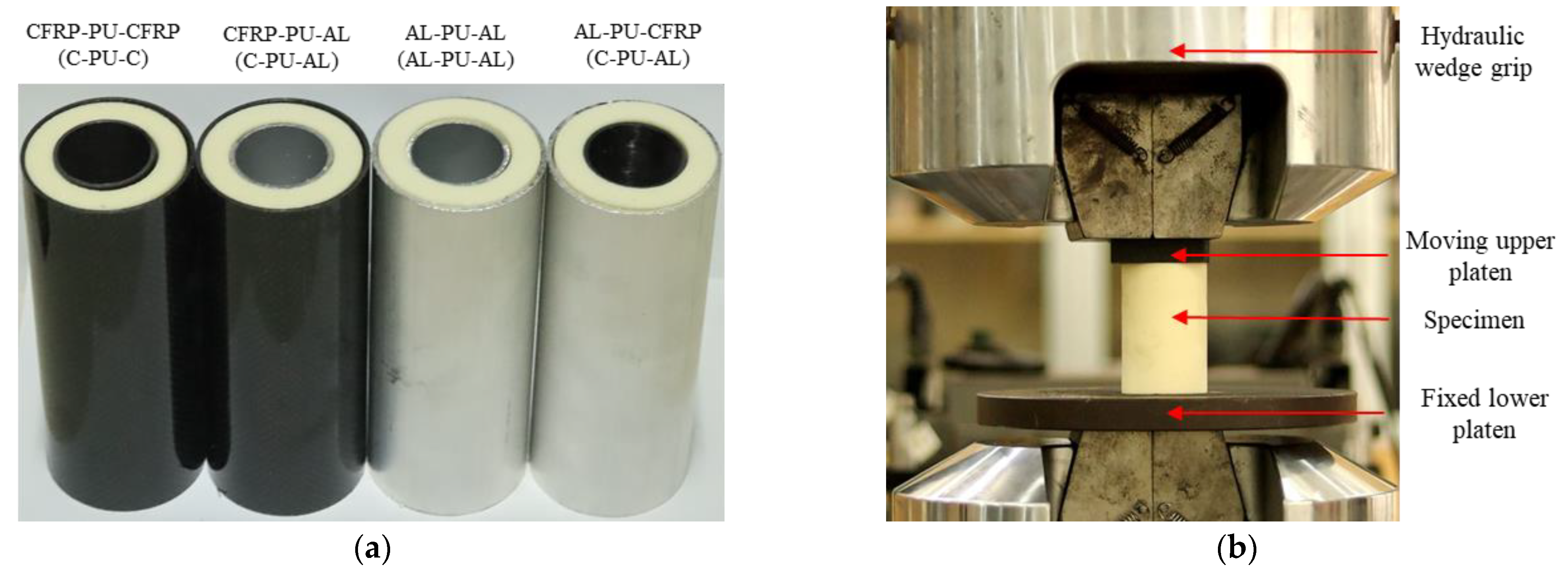
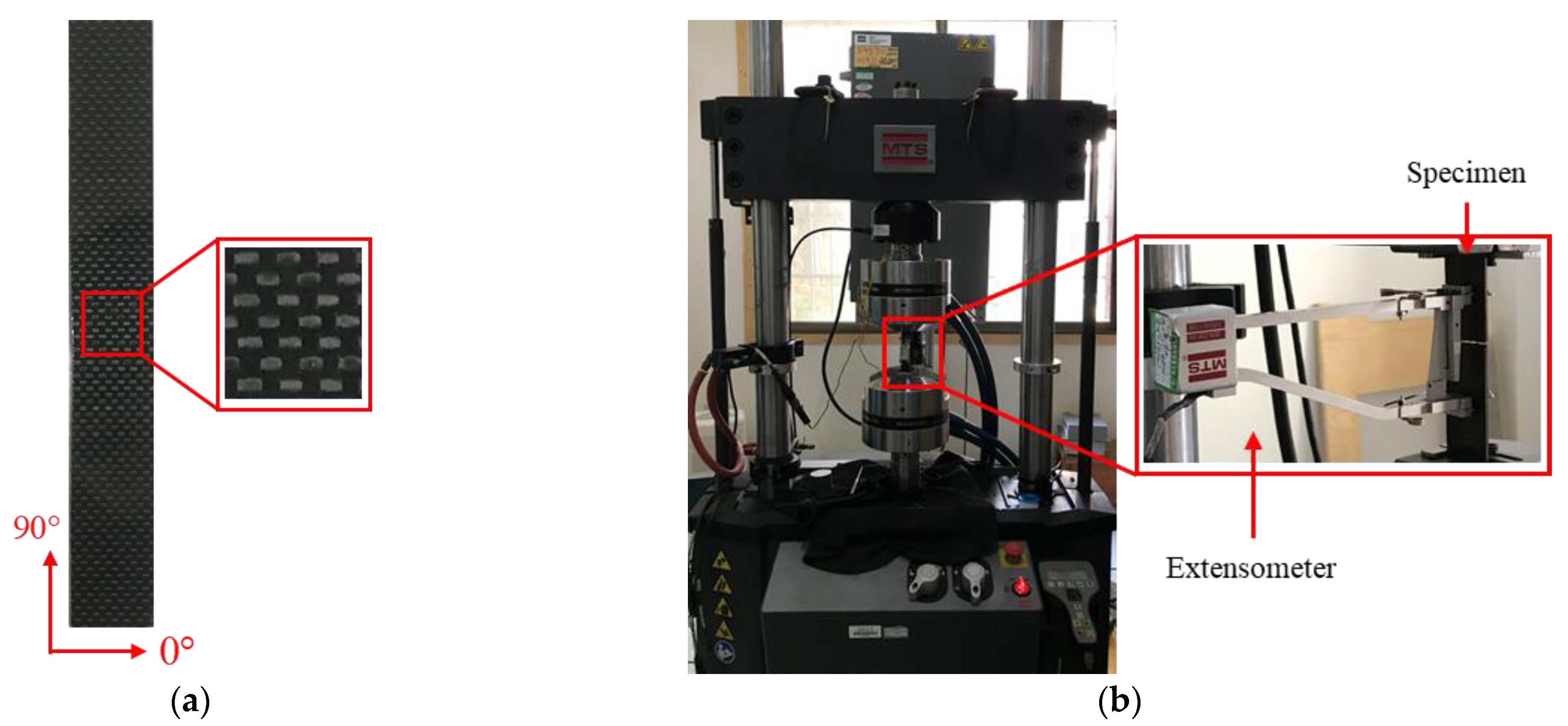
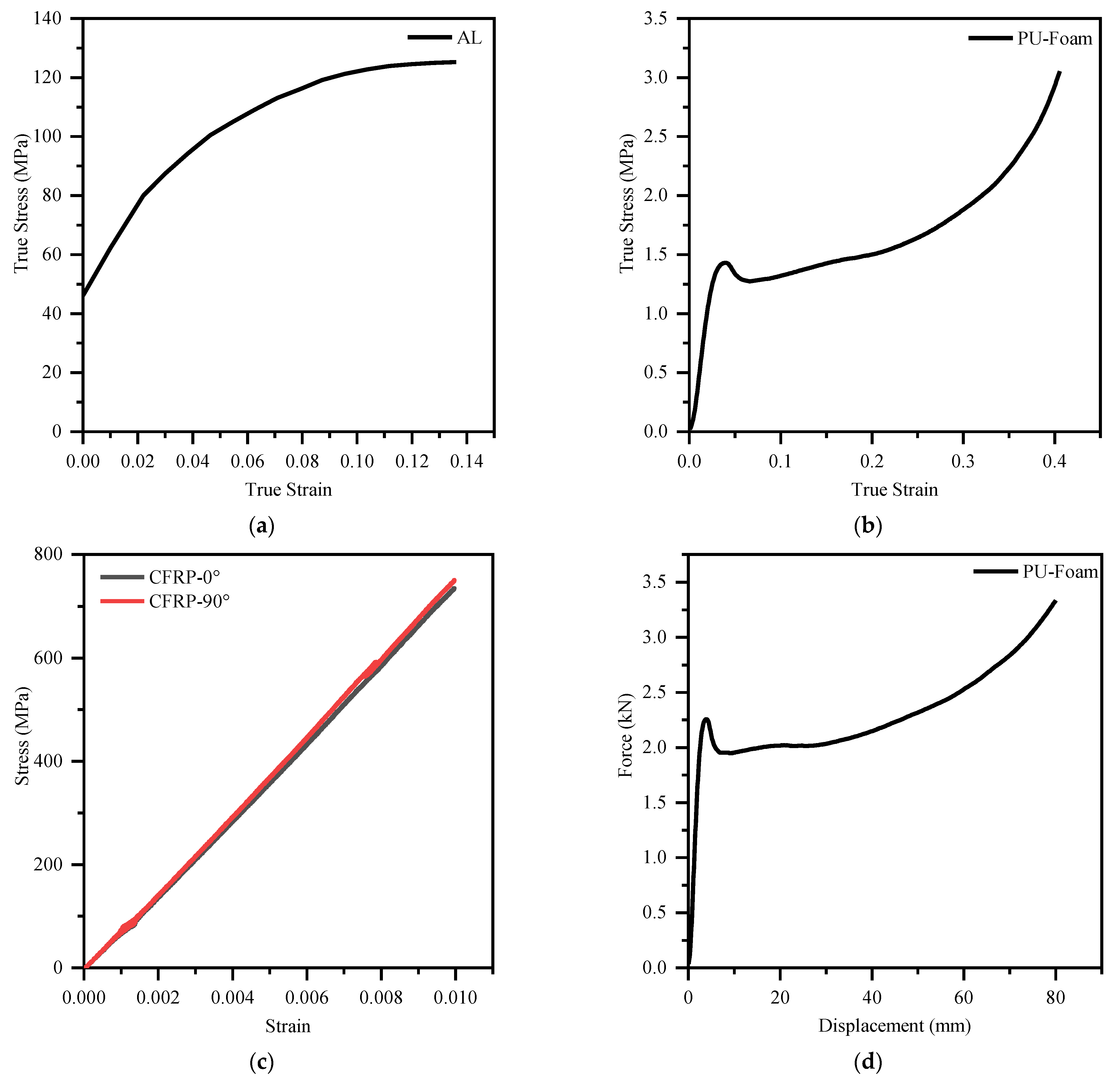
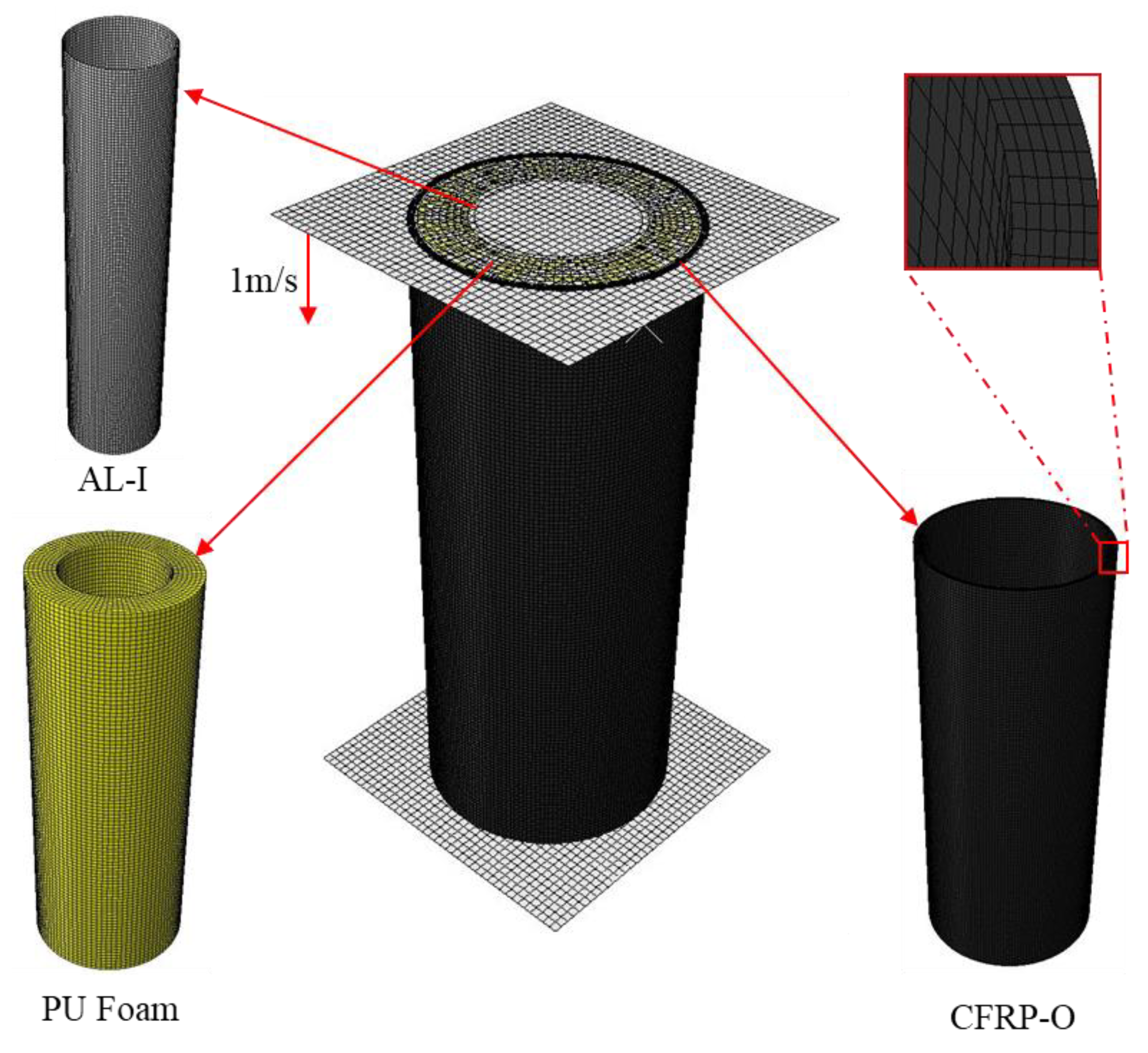


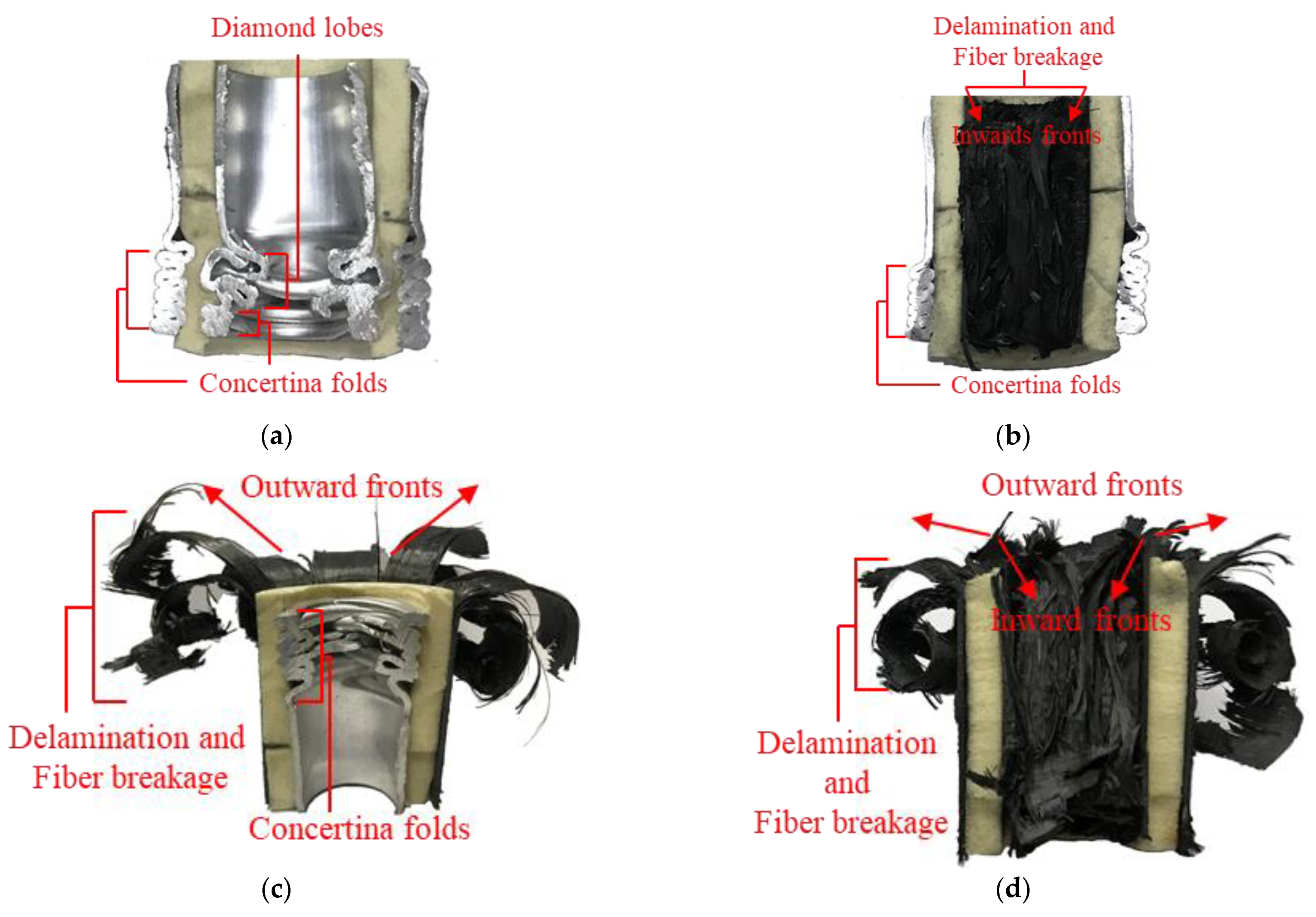
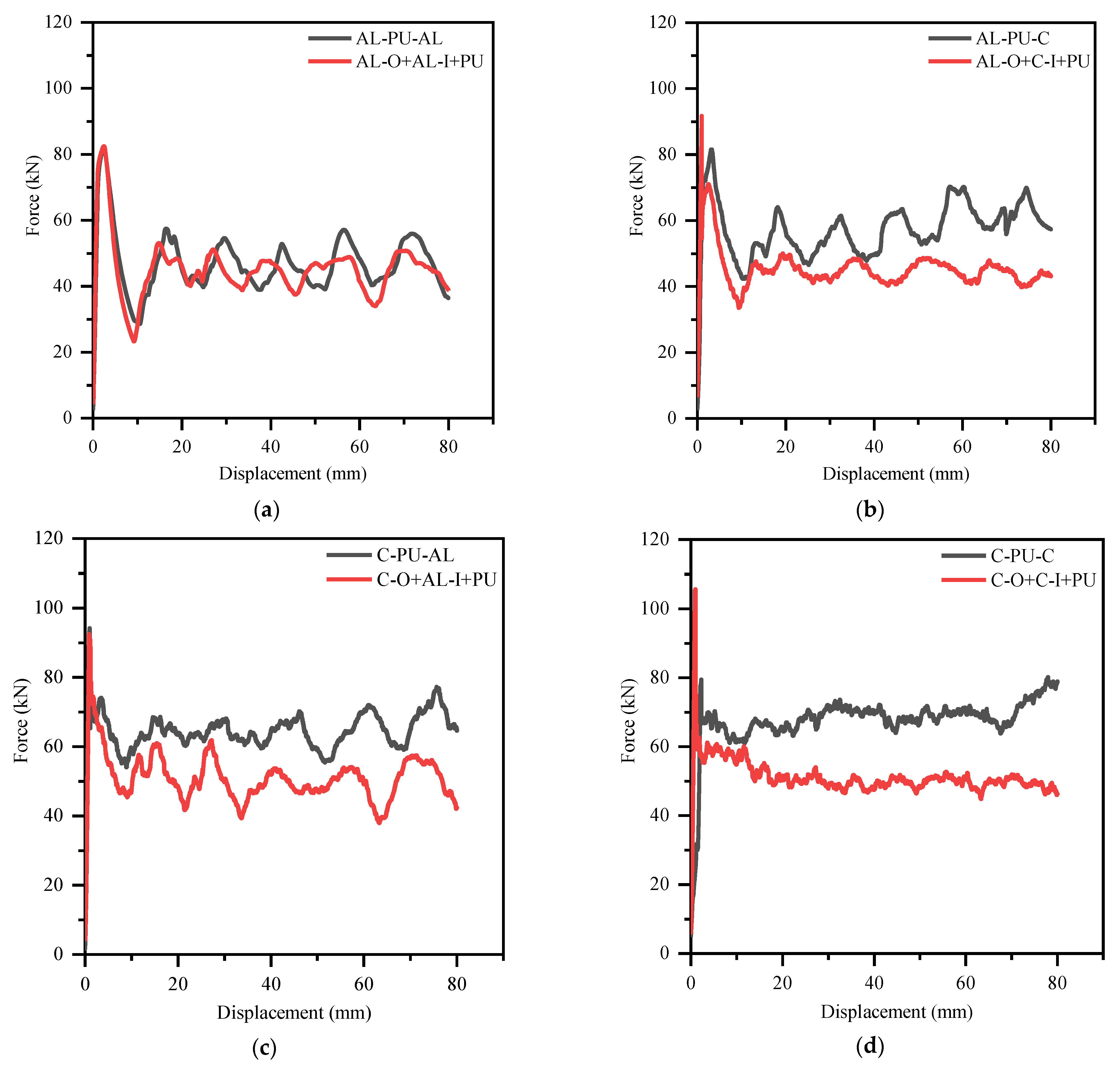

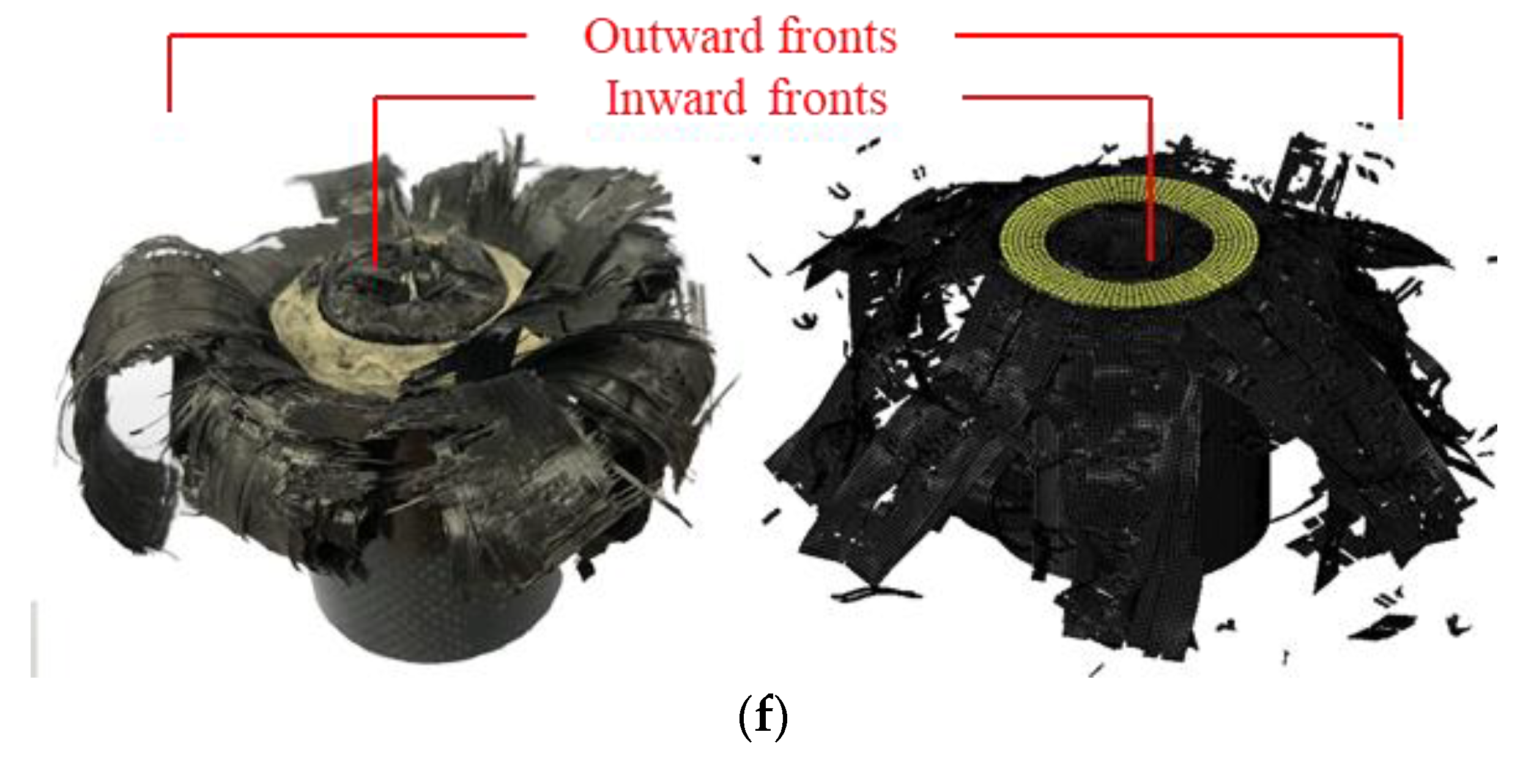
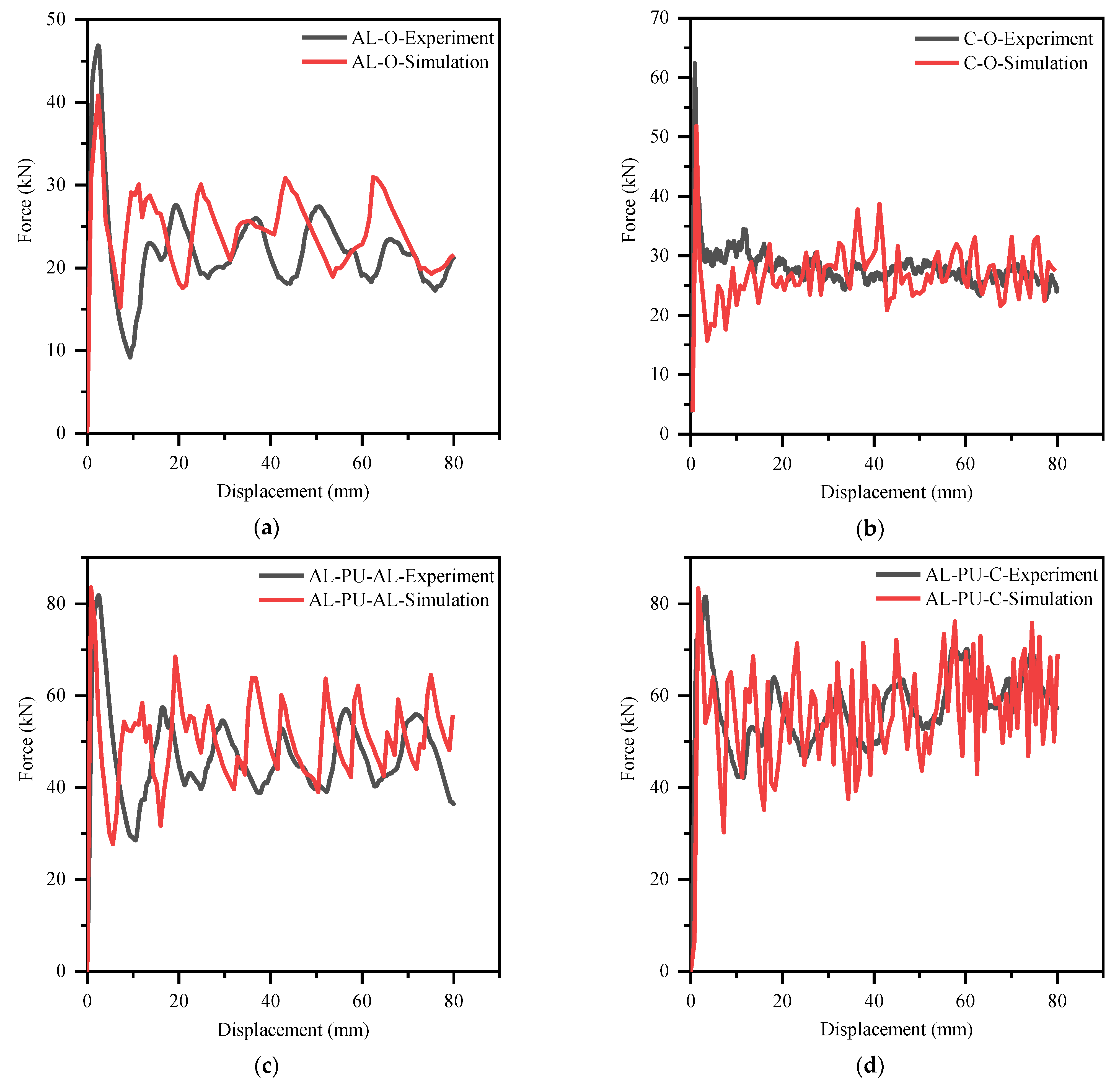

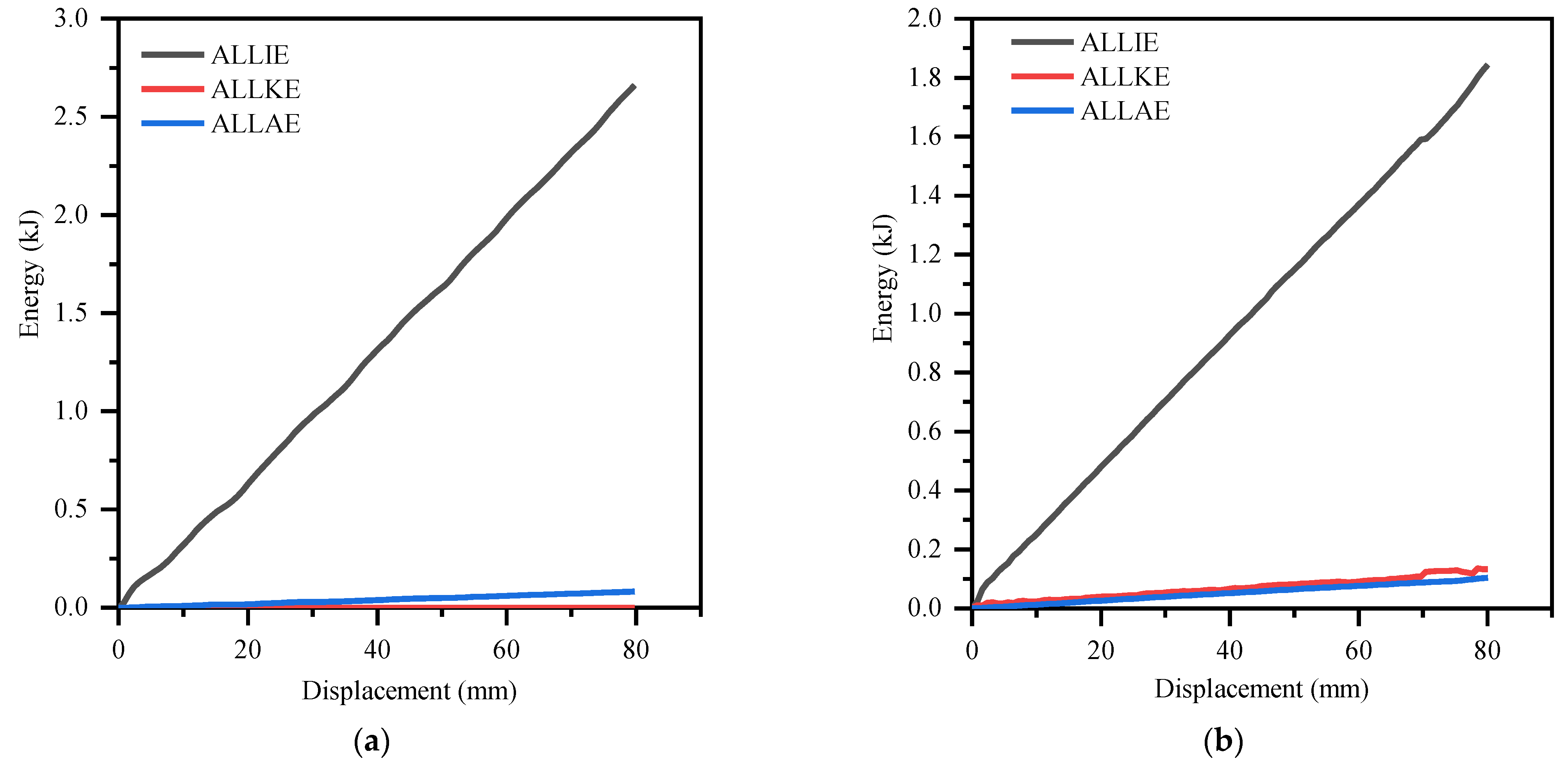
| Specimens | Thickness (mm) | Weight (g) | Diameter D (mm) | Length (mm) | Density ρ (g/cm3) | Materials |
|---|---|---|---|---|---|---|
| CFRP-I | 1.5 | 36.9 | 35 | 150 | 1.5 | T300/epoxy |
| CFRP-O | 1.5 | 64.5 | 60 | 150 | 1.5 | T300/epoxy |
| AL-I | 1.5 | 63.9 | 35 | 150 | 2.7 | AA6061 |
| AL-O | 1.5 | 111.6 | 60 | 150 | 2.7 | AA6061 |
| Foam | - | 49.2 | 56 | 100 | 0.2 | Polyurethane |
| Foam-H | 10 | 43.3 | 56 | 150 | 0.2 | Polyurethane |
| AL-PU-AL | - | 218.8 | 60 | 150 | - | AL-PU-AL |
| AL-PU-C | - | 191.8 | 60 | 150 | - | AL-PU-CFRP |
| C-PU-AL | - | 171.7 | 60 | 150 | - | CFRP-PU-AL |
| C-PU-C | - | 144.7 | 60 | 150 | - | CFRP-PU-CFRP |
| Description | Variable | Value |
|---|---|---|
| Density(kg/m3) | ρ | 1560 |
| Elastic properties (GPa) | E1 | 7.5 |
| - | E2 | 7.4 |
| - | G12 | 5.0 |
| - | ν12 | 0.04 |
| Damage initiation (MPa) | X1+ | 789 |
| - | X1- | 704 |
| - | X2+ | 748 |
| - | X2+ | 698 |
| - | S | 107 |
| Fracture energies (kJ/m2) | 95 | |
| - | 145 | |
| - | 90 | |
| - | 140 |
| Specimens | EA (kJ) | SEA (kJ/kg) | PF (kN) | MF (kN) |
|---|---|---|---|---|
| CFRP-I | 1.7 | 44.9 | 50.5 | 21.3 |
| CFRP-O | 2.3 | 34.6 | 62.4 | 28.8 |
| AL-I | 1.6 | 25.6 | 35.2 | 20.0 |
| AL-O | 1.8 | 15.8 | 46.8 | 22.5 |
| Foam-H | 0.2 | 4.6 | - | 2.5 |
| AL-PU-AL | 3.7 | 16.9 | 81.8 | 46.3 |
| AL-PU-C | 4.6 | 24.0 | 81.5 | 57.5 |
| C-PU-AL | 5.2 | 30.3 | 94.1 | 65.0 |
| C-PU-C | 5.4 | 37.3 | 79.5 | 67.5 |
| Simulations | EA (kJ) | SEA (kJ/kg) | PF (kN) | MF (kN) |
|---|---|---|---|---|
| CFRP-O | 2.2 | 34.1 | 51.7 | 27.5 |
| AL-O | 1.9 | 17.1 | 40.8 | 23.8 |
| Foam-H | 0.2 | 4.6 | -- | 2.5 |
| AL-PU-AL | 4.0 | 18.3 | 83.5 | 50.0 |
| AL-PU-C | 4.5 | 23.5 | 83.4 | 56.3 |
| C-PU-AL | 5.3 | 30.9 | 93.8 | 66.3 |
| C-PU-C | 5.4 | 37.3 | 82.5 | 67.5 |
| Specimen | EA | SEA | PF | MF |
|---|---|---|---|---|
| CFRP-O | 0.3 | 0.7 | 3.2 | 2.2 |
| AL-O | 0.3 | 1.1 | 2.4 | 1.1 |
| Foam-H | 0.2 | 0.2 | -- | 0.1 |
| AL-PU-AL | 0.5 | 1.2 | 1.3 | 1.9 |
| AL-PU-C | 0.3 | 0.7 | 1.4 | 1.1 |
| C-PU-AL | 0.3 | 0.8 | 0.5 | 1.2 |
| C-PU-C | 0.3 | 0.2 | 1.7 | 0.3 |
Publisher’s Note: MDPI stays neutral with regard to jurisdictional claims in published maps and institutional affiliations. |
© 2021 by the authors. Licensee MDPI, Basel, Switzerland. This article is an open access article distributed under the terms and conditions of the Creative Commons Attribution (CC BY) license (http://creativecommons.org/licenses/by/4.0/).
Share and Cite
Yao, S.; Chen, Z.; Xu, P.; Li, Z.; Zhao, Z. Experimental and Numerical Study on the Energy Absorption of Polyurethane Foam-Filled Metal/Composite Hybrid Structures. Metals 2021, 11, 118. https://doi.org/10.3390/met11010118
Yao S, Chen Z, Xu P, Li Z, Zhao Z. Experimental and Numerical Study on the Energy Absorption of Polyurethane Foam-Filled Metal/Composite Hybrid Structures. Metals. 2021; 11(1):118. https://doi.org/10.3390/met11010118
Chicago/Turabian StyleYao, Shuguang, Zhifang Chen, Ping Xu, Zhixiang Li, and Ziliang Zhao. 2021. "Experimental and Numerical Study on the Energy Absorption of Polyurethane Foam-Filled Metal/Composite Hybrid Structures" Metals 11, no. 1: 118. https://doi.org/10.3390/met11010118
APA StyleYao, S., Chen, Z., Xu, P., Li, Z., & Zhao, Z. (2021). Experimental and Numerical Study on the Energy Absorption of Polyurethane Foam-Filled Metal/Composite Hybrid Structures. Metals, 11(1), 118. https://doi.org/10.3390/met11010118




